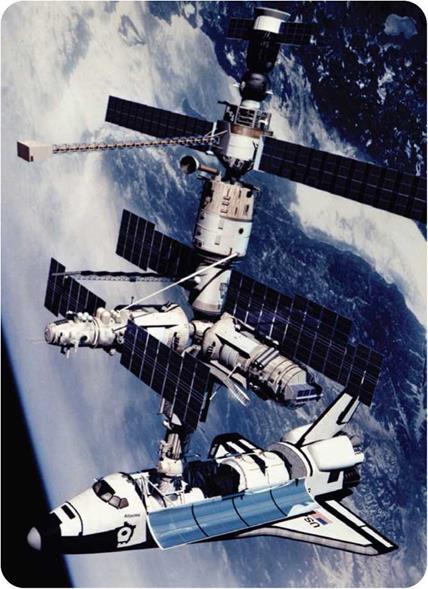Using Radar in Space
Since the early days of manned spaceflight, spacecraft have been able to dock (link up) with each other. The Gemini program carried out the first docking in 1966 as a step toward a successful Moon landing mission. Apollo Command Modules docked with the U. S. Skylab space station. The Space Shuttle, Soyuz
DEFEATING RADAR
During the Cold War, the United States and Soviet Union competed with each other to produce the most advanced military radar for their combat aircraft. They also developed ground-based radar to give early warning of a missile attack. This competition led to research into ways of defeating enemy radar. There are six main methods used to confuse or block radar systems:
• Electronic jamming: Sending out radio signals to block or swamp enemy radar.
• Generating false targets:
Sending out radio signals that make extra, confusing information appear on enemy radar screens.
• Chaff: Dropping metal strips from an aircraft to create confusing radar reflections.
• Decoys: Employing small flying objects that look like full-size aircraft on a radar screen.
• Anti-radiation missiles:
Destroying enemy radar by homing in on radio signals they transmit.
• Stealth: Manufacturing military aircraft that produce little or no radar reflection.
_______________ J
 capsules, and unmanned Progress supply craft have docked with the Russian Mir space station and with the International Space Station.
capsules, and unmanned Progress supply craft have docked with the Russian Mir space station and with the International Space Station.
Docking is a difficult maneuver. In space, without any nearby landmarks by which to judge distance and speed, it is almost impossible to determine how far away a spacecraft is or how fast it is moving. A crew onboard the Mir
О Joining one spacecraft with another in space is called docking, and radar is needed for this maneuver to measure distances and speed of approach. This computer-generated image shows the Space Shuttle Atlantis docked to the Russian space station Mir, which orbited Earth from 1986 to 2001.
space station in 1997 discovered this problem when they were docking an unmanned supply craft with their space station without the use of radar. The craft, controlled by a cosmonaut in Mir, approached the station too fast and crashed into it.
Radar is usually used for all docking maneuvers. It provides accurate measurements of the distance between spacecraft and their closing speed. Linked to a spacecraft’s guidance system, it can carry out docking automatically. When the Apollo lunar excursion modules descended from lunar orbit to the Moon’s surface during the Apollo landings of the 1960s and 1970s, the descent was controlled by radar. Landing radar kept the guidance computer constantly updated with data on the spacecraft’s altitude and rate of descent.
![]()
|
|










